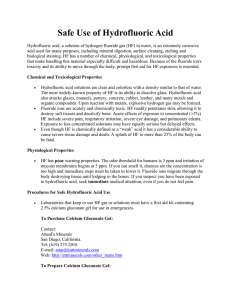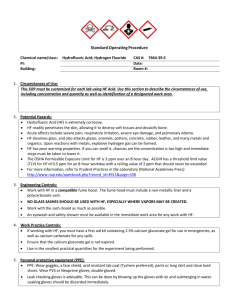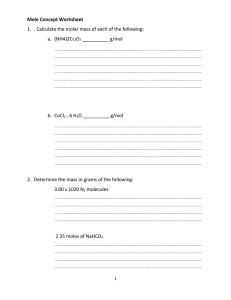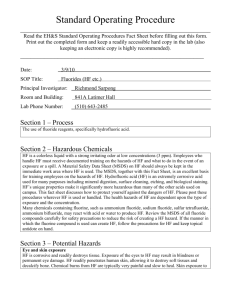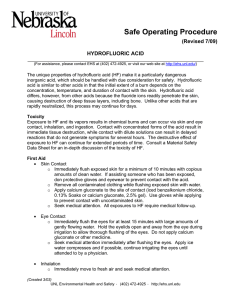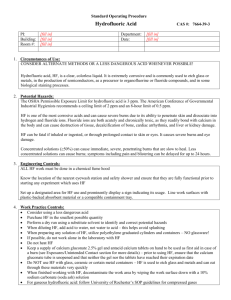The University of Warwick Physics Department SAFE OPERATING PROCEDURE
advertisement
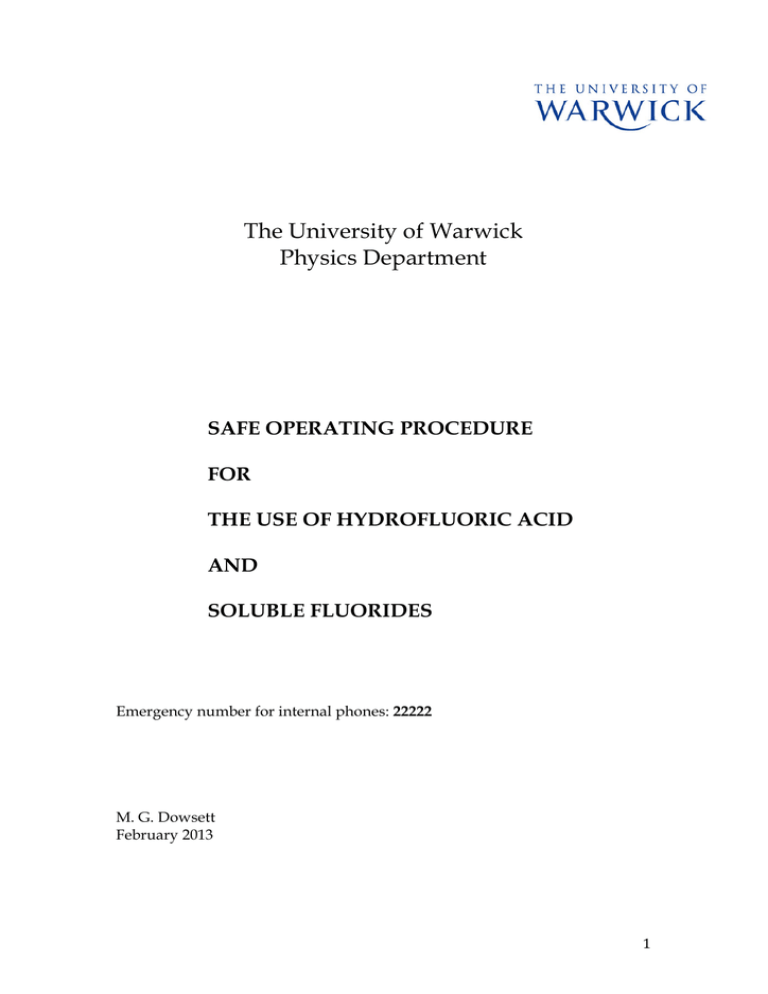
The University of Warwick Physics Department SAFE OPERATING PROCEDURE FOR THE USE OF HYDROFLUORIC ACID AND SOLUBLE FLUORIDES Emergency number for internal phones: 22222 M. G. Dowsett February 2013 1 The University of Warwick Physics Department SAFE OPERATING PROCEDURE FOR THE USE OF HYDROFLUORIC ACID AND SOLUBLE FLUORIDES 1. Nomenclature 3 2. Introduction 3 3. Use of HF and soluble fluorides in the Physics Department 4 3.1 Approved users 4 3.2 The Operator – Observer (OO) Principle 4 4. Toxicity of HF and soluble fluorides 5 4.1 The effects 5 4.2 Routes into the body 6 5. First aid and subsequent steps 6 5.1 Introduction 6 5.2 The six steps in assisting a victim with fluoride exposure to the skin: 6 5.3 The four steps in assisting a victim of inhalation or ingestion 7 5.4 The four steps in assisting a victim with hydrofluoric acid splashed in their eyes 7 5.5 A note on the use of calcium gluconate gel 8 6. Personal Protective Equipment (PPE) 8 6.1 Requirements 8 6.2 Dress code 9 6.3 Care and maintenance 9 6.4 Gloves 9 7. Working environment 10 7.1 The Chemicals 10 7.2 The Laboratory 10 7.3 The Work Station 11 7.4 Porterage 11 8. Materials for use with HF 12 9. Accidents and emergencies other than personal exposure 15 9.1 Power cuts 15 9.2 Spills inside the work station 15 9.3 Spills outside the workstation 15 10. Safe disposal 16 10.1 General procedure 16 10.2 Approved neutralizing agents, quantities and by-products 17 10.3 Neutralizing HF(aq) 17 10.4 Neutralizing sodium fluoride solution 19 10.5 Neutralizing other soluble fluorides and (hexa)fluorosilicic acid 20 11. Safe Working Regulations 21 References 22 Contact Sheet 23 2 The University of Warwick Physics Department SAFE OPERATING PROCEDURE FOR THE USE OF HYDROFLUORIC ACID AND SOLUBLE FLUORIDES Curiosity may have killed the cat, but curiosity about your work may save your life. 1. Nomenclature DSO Departmental Safety Officer HF Used here as a generic term for substances containing hydrogen fluoride at any strength. The dangers of other soluble fluorides, e.g. sodium fluoride, are similar, and this document applies to all these, even where only HF is mentioned specifically. These substances are extremely toxic because they are a source of fluorine. HF(aq.) Used when referring specifically to the aqueous solution of HF (hydrofluoric acid) Hypocalcaemia Lack of calcium in blood and body fluid – a principal cause of death when fluorine gets into the body. Hypomagnesaemia Lack of magnesium in the blood and body fluids, also extremely dangerous. Spill kit A proprietary kit to be kept by each workstation for use in the event of a minor spill outside the workstation. Work station A fume cupboard, wet bench or other facility designated specifically for the use of HF. 2. Introduction HF is a virulent neurotoxin, a muscle inhibitor, and causes bone disintegration, all in addition to its corrosive and tissue destroying effects as an acid. It is also hard for emergency services to deal with because almost all the normal palliative actions triggered by the word “acid” either have no useful effect, or make things worse. For example, typical treatment for acid burns involves the use of a saline loaded dressing. In the case of HF, this results in the local production of sodium fluoride which exhibits exactly the same hazards as above with the addition of being mutagenic. HF is readily absorbed through the skin, mucus membranes, and the lungs. HF(aq.) is an effective source of HF gas, so the acquisition of lethal dose by inhalation is straightforward. Untreated or incorrectly treated exposure to HF is usually fatal. 3 Rinsing an exposed area is inadequate on its own because the substance is so rapidly absorbed that the internal consequences need to be dealt with at once. For example1, in 1995 a laboratory technician in Perth (Australia) provided with totally inadequate personal protection equipment (PPE) spilt about 100 ml of HF at an unknown concentration down one leg. He immediately hosed the region off with water, called the emergency services, and waited for them in a nearby swimming pool. He did not apply any topical remedy (calcium gluconate gel was not available) and he did not remove the affected clothing. Only 9.5% of his body area was exposed. Nevertheless, although his leg was amputated and he received intensive treatment designed to restore the calcium levels in his body, he died after 15 days from hydrogen fluoride poisoning. It is suspected that a significant contribution to his death was inhalation of HF gas from the spill in the first few seconds of the accident. These rules are intended to ensure that nothing remotely like this ever happens here. 3. Use of HF and soluble fluorides in the Physics Department 3.1 Approved users The use of HF is governed by the local rules contained in this document. HF and related substances may only be handled in a work station or fume cupboard designated specifically for the purpose. Only individuals on the list of Approved Users may work with these materials. To become an Approved User it is necessary to take the Department’s HF safety course and pass the associated tests. A detailed knowledge of this document will be expected. Under no circumstances will undergraduates be allowed to work with HF or soluble fluorides. The devolution of responsibility for working with HF to an untrained person is a disciplinary offence. Approved Users do NOT have a mandate to give training. 3.2 The Operator – Observer (OO) Principle The Department’s safety procedure is based on the operator-observer (OO) principle. An individual working with HF (the operator) will be accompanied at all times by an observer. The operator’s role is to run the necessary process in accordance with the rules herein. The observer’s role is to render immediate assistance in the event of an accident where this is consistent with their own personal safety, to summon more general first aid, to ensure that the emergency services are called, to make sure that any other necessary action is taken (this may include evacuation of the laboratory or the building) and, if necessary, to act as a source of information on HF to ensure that any medical or hospital treatment is relevant to the problem. To ease the latter role, a contact sheet is provided 4 at the end of this document and should be presented to medical, paramedical or casualty staff. The OO principle applies equally to work in the laboratory and to carriage of materials between approved stores and the laboratory. i.e. ONLY approved users may carry containers of HF around the building and they must be accompanied by an observer. 4. Toxicity of HF and soluble fluorides 4.1 The effects The reaction between calcium and fluorine ions in solution goes like this: Ca++ + 2F- CaF2 The calcium is precipitated as insoluble calcium fluoride. This is both the key to making the substance safe, and to its deadly action on the humans and animal life generally. The viability of the human body depends on calcium ions in solution in body fluids. Calcium ion exchange plays a key role in both neurotransmission and muscle action. The action of any fluorine ions entering the body is to precipitate the calcium causing severe hypocalcaemia. (HF also gives rise to a similar effect on magnesium causing hypomagnesaemia.) Fluorine ion absorption inhibits vital processes first locally, and very soon afterwards (as little as 15 s for a severe exposure) systemically. Localized exposure may go unnoticed because the sharp pain which would be felt with another acid is dulled by the killing of the pain receptors, and their links to the brain. The effects of exposure are highly variable and may not result in obvious symptoms until hours or even days afterwards. Depending on the level of exposure they include severe tissue damage resulting in mortification of bones, muscles, skin, etc. extreme pain, a dull ache, lack of sensation paralysis shock confusion massive organ failure unconsciousness death Absorption of fluorine ions can cause long term damage. The bones are attacked and their microscopic cross-linked structure is destroyed. The resulting material has no mechanical strength and collapses leaving the tissue unsupported. For example, during World War II a female technician working with hydrofluoric acid in the early days of uranium separation was exposed repeatedly through an unnoticed pin hole in a glove. The technician survived, but lost her hand because of the severe bone and tissue damage. Some version of this accident has occurred repeatedly since then2,3, 5 and even where the victim survives, recovery is painful and can take months or even years3. 4.2 Routes into the body ingestion – the substance is swallowed inhalation – the vapour is breathed instillation – the substance is absorbed via the eyes or the nose following exposure to droplets absorption – entry is through the skin 5. First aid and subsequent steps 5.1 Introduction Past fatalities have occurred for two reasons only. (i) Massive untreatable exposure. (ii) Treatment failure following exposure (delayed, incorrect or none). Individuals have been killed by exposures of 2.5% of body area or less to concentrated HF(aq) because of poor post exposure treatment. Conversely, exposures as high as 22% have been survived where the correct measures were taken immediately. IN ALL CASES, SUSPECTED EXPOSURE SHALL BE TREATED AS EXPOSURE. The Observer is responsible for the giving of immediate HF specific first aid. At the earliest opportunity phone 22222 (or get someone else to do this) and arrange for an ambulance. You may also summon help from Departmental First Aiders. 5.2 The six steps in assisting a victim with fluoride exposure to the skin: Make the area safe and take precautions to make sure that neither you, nor anyone working nearby, is jeopardized. This may entail other personnel leaving the laboratory. Don the appropriate protective equipment (see §6, Personal Protective Equipment). Remove all affected clothing as rapidly as possible, but with as little further contact to the affected individual as possible. Lay this aside safely (e.g. in a bucket of water in the work station for later safe disposal or double bagged in polyethylene bags). DO NOT RINSE THROUGH CLOTHING – this will spread the problem around. Rinse/sluice off the affected area for 3-5 minutes with copious quantities of fresh water in a jet or from a soft dispersal nozzle. 6 Immediately apply liberal quantities of calcium gluconate gel to the affected region. Keep on rubbing this in both locally and around the affected area. The victim MUST be removed to hospital, and calcium gluconate treatment MUST be continued in the ambulance (see Contact Sheet). Medical and paramedical staff must be made aware that the patient has been exposed to hydrogen fluoride (see Contact Sheet) and that the remedial treatment differs from that for other acids. 5.3 The four steps in assisting a victim of inhalation or ingestion (May be required additionally to 5.2) Make the area safe and take precautions to make sure that neither you, nor anyone working nearby, is jeopardized (see §6, Personal Protective Equipment). If the victim has HF splashed in the nose, apply calcium gluconate gel directly to the inside of the nostrils, do not attempt irrigation. OR If the victim has swallowed HF wash the mouth out with a cup of water. Do not give large quantities to drink. Do not induce vomiting. It may be useful to give about half a cup full of water, milk, or anti-acid (e.g. Milk of Magnesia in water). If the victim vomits spontaneously, assist them with physical support. The vomit should be treated as an HF hazard. The victim must be removed to hospital as soon as possible, even if there are no visible signs of exposure. Medical and paramedical staff must be made aware that the patient has been exposed to hydrogen fluoride vapour by inhalation or has ingested the liquid (see Contact Sheet) and that specialized poisons treatment is urgently required. 5.4 The four steps in assisting a victim with hydrofluoric acid splashed in their eyes Make the area safe and take precautions to make sure that neither you, nor anyone working nearby, are jeopardized (see §6, Personal Protective Equipment). If available, immediately treat with Hexafluorine eyewash according to the instructions. OR Rinse the affected area with copious quantities of fresh water from a soft dispersal nozzle, or using a non-saline eye wash. 7 The victim must be removed to hospital as soon as possible, even if there are no visible signs of exposure. Medical and paramedical staff must be made aware that the patient has been exposed to hydrogen fluoride by instillation (see Contact Sheet) and that specialized poisons treatment is urgently required. An accident where an individual has the liquid spilt on their skin may also involve spillage of hydrofluoric acid on the floor or exterior bench work. This must be made safe where possible and the affected laboratory must be evacuated by non-essential personnel. In the case of a larger scale spill (> 500 mL at > 30% w/w) it will be necessary to evacuate the building and call the Fire Brigade. 5.5 A note on the use of calcium gluconate gel Calcium gluconate gel feels cold and sticky and dries on the skin to form a white peeling crust. Moreover, the underlying skin will appear to be red and inflamed, even if there has been no exposure to HF. The white peeling surface and the red skin below looks superficially like severe skin damage and may prompt medical staff to react in the wrong way. See the Contact Sheet at the end of this document. 6. Personal Protective Equipment (PPE) 6.1 Requirements Adequate PPE can reduce a potentially lethal event to a minor inconvenience. For hydrofluoric acid, the Department works on the basis of informed personal responsibility for PPE. i.e. Each individual authorized to work with HF will be supplied with and maintain their own PPE (with the exception of disposable gloves which will be available at the work stations). PPE will not be shared between individuals. Suspect PPE will be immediately destroyed and replaced. The responsibility for checking the integrity of PPE rests with the individual using it. The minimum PPE for working with hydrofluoric acid or soluble fluorides inside an approved workstation is: Full face splash proof visor to EN166 1 B 3 or better Hydrofluoric acid resistant full length, long sleeved smock Hydrofluoric acid resistant boots Disposable hydrofluoric acid resistant gloves (two pairs, both to be worn) or long HF resistant gloves (elbow or shoulder length) with a pair of disposable gloves worn inside Disposable HF nuisance mask e.g. 3M 9906 (for spills and porterage) An individual giving first aid will need at least: 8 Disposable hydrofluoric acid resistant gloves (two pairs, both to be worn) Disposable HF nuisance mask. Some or all of the following may also be necessary depending on the level and concentration of the exposure Full face splash proof visor to EN 166 1 B 3 or better Hydrofluoric acid resistant full length, long sleeved smock Hydrofluoric acid resistant boots. 6.2 Dress code 1. The sleeves of the smock must be outside the gloves and not tucked into them, unless the gloves are elbow length or more. 2. The bottom of the smock must have an overlap of at least 150 mm with the tops of the boots, and must be worn outside them. i.e. it must not be possible for liquid splashed on the smock to flow into the boots or gloves. 6.3 Care and maintenance The storage and care of an individual’s PPE is their own responsibility. If HF is spilt on the PPE, the affected item must immediately be carefully rinsed or sluiced off, in the workstation or the emergency shower nearby. It may well be best to do this without removing the item. This counts as a procedure involving HF and is subject to all the rules herein. In particular, the process must not create an additional hazard for the PPE owner or others in the vicinity. Items must be thoroughly clean and dry prior to storage. The user must be assured of the integrity of the clothing, and any doubtful items must be replaced. 6.4 Gloves GLOVES DO NOT MAKE YOU SAFE! The most common cause of HF exposure is a pinhole in a glove, so pay special attention to these. There appears to be no rigorous scientific basis for the recommendation of any common glove material over any other. Company representatives simply do not have the specialized knowledge to help with a recommendation and merely repeat what it says in their catalogue. None out of natural rubber, Nitrile, Polychloroprene, Vinyl, Neoprene or the rest forms anything more than a short term barrier and the author is not aware of reliable tests of any of these materials above HF strengths of 48% anyway. Worse still, different sources (even from the same supplier) conflict about their relative effectiveness, some rating natural rubber as the best, some extolling Nitrile, and some claiming neither can be used. 9 What is true is: Gloves of whatever type must be seamless Gloves only ever offer splash protection. You must NEVER immerse gloved fingers in HF ANY glove splashed with HF should be rinsed, removed and discarded (in that order). All gloves are permeable to HF except (possibly) as noted below. If you use outer gloves which are “non-disposable” they must be replaced as above if splashed, and in any case every six months. A typical suppliers disclaimer is that a purchaser is responsible for testing gloves themselves. Gloves should be worn like this: Wear your gloves for 30 minutes at most. Rinse the outer pair and discard if they are disposable. Rinse the inner pair and discard. Wash your hands. Don new gloves. Linear low density polyethylene (LLDPE) gloves provide the most resistance in any published test and this is consistent with the material properties as listed in reference 4. They are hard to source. 7. Working environment 7.1 The Chemicals Open HF containing vessels must not be taken outside a workstation. Open HF containing vessels must never be left unattended except in an emergency. All chemicals which are left unattended, or which are to be transported, must be in closed containers made from suitably resistant materials and have secure lids. Such containers must be clearly and indelibly labelled with the name of the chemical they contain and its strength. Chemicals in sealed containers must be returned to an appropriate store and not left in the work station. 7.2 The Laboratory The laboratory environment must be clear and uncluttered with free access to the emergency shower and sinks. There will be no loose items on the floor. Work benches will contain the minimum amount of equipment and containers required for the processes under way. Unused materials and equipment will be put away immediately. Sinks and drainers will not be left covered in chemical ware requiring cleaning. 10 7.3 The Work Station The working surfaces in the work station will be kept clear and uncluttered using the minimum amount of space for chemical containers and equipment. The work station will not be used to store chemicals. HF resistant materials (see §8) will be used for vessels and equipment in the workstation. The safety equipment listed in Table 1 will be available immediately adjacent to any workstation using HF or soluble fluorides in the Physics Department. The operator and observer should ensure that this is the case before commencing work. What Minimum quantity Comment Small tubes are not acceptable. Calcium gluconate gel 2 x 500 g tubs Topical application to exposed skin. Wall mounted grab Effective chelation and barrier for HF Hexafluorine eye wash pack in eyes or on face Essential chaser if HF swallowed Milk of magnesia 1 x 200 mL bottle (MgO chelates fluorine ions) Natural rubber, nitrile or neoprene. MUST BE SEAMLESS. Gloved hands must NOT be immersed in HF. No gloves exist which form a permanent impermeable barrier to HF. If gloves are splashed, rinse S, M, L, and XL remove, discard immediately. to be supplied Wear two pairs, or one pair inside Snug fit disposable gloves 1 pk 100 in use, "non disposable" gloves. (surgical glove style) 1 pk 100 full Do not wear for more than 30 min. High proportion of MgO, suitable for spills outside work Spill-X-A powder 1 x 22.7 kg plastic pail stations Spill-X-A powder 1 x 1.1 kg container For small spills Table 1: Minimum level of safety equipment to be provided adjacent to a work station. Work with the sash in the lowest practical position, and never raise the sash above the maximum level marked when the work station contains any HF. Never put your head inside the workstation when attempting to clean up spills. 7.4 Porterage From time to time it will be necessary to carry HF or a related substance through the building to the laboratory where it is to be used. The following procedure will be adopted. 11 Porterage must be planned in advance and carried out when the levels of traffic on stairwells and in corridors is low (e.g. avoid the period between fiveto and five-past the hour during term time). Lifts must not be used. The OO pair will carry HF resistant disposable gloves and HF nuisance masks to be worn in the event of an emergency. The operator will carry the material in an approved container which must be sealed and in a bottle carrier or crate. The observer will accompany them (walking in front) to assist with appropriate action in the event of a spill. (See §9) 8. Materials for use with HF HF dissolves silica and silica related materials such as glass, so these materials must not be used with HF at any strength. The substance also causes stress cracking in polymer and resin based materials such as polypropylene and acrylic (e.g. Perspex®) so these materials can become defective and must not be used. (An exception to this is the use of polypropylene containers made from sheet welded at the edges. These containers must be limited to a maximum of 40% w/w HF(aq), and users are advised to inspect them regularly for evidence of failure.) Many other polymers are suitable for the containment of HF, especially fluoropolymers (with the exception of fluorinated polyethylene (FPE)). Polyethylene itself is also suitable up to quite high concentrations. Suitable fittings and pipework are commercially available in PVDF, ETFE and PTFE, and polyethylene, PTFE, PVDF, PCTFE, are suitable materials for vessel fabrication or purchased chemical ware. They are available as rod or sheet, and may be welded by a specialized fabricator. Polyethylene is difficult to machine successfully, but is excellent in cast and injection moulded items. PTFE and PCTFE can be machined readily to a good surface finish and tolerances significantly smaller than 0.1 mm. PCTFE is harder and more dimensionally stable and is more suitable for threading and intricate detail, but it is much more expensive. All polymers have high expansion coefficients in comparison to metals (>120 ppm / °C compared to 720 ppm / °C). For sealing materials (e.g. gaskets and O rings) you should seek specific information according to the application. Note that all fluoropolymers decompose to emit or become coated with HF if heated excessively. (Typically excessive heating means over 300 °C or burning.) They therefore become hazardous in their own right and are regularly the cause of accidents. Table 2 gives more information on limitations and range of use of common engineering polymers and speciality fluoropolymers. NEVER USE POLYMERS CONTAINING FILLER SUCH AS FLUROSINT. POLYMERS SHOULD BE “NATURAL” OR SIMPLY PURE. Fluoropolymers may not be cast or welded in the Physics Department as this requires specialized facilities. Caution must be exercised when machining fluoropolymers. Sharp tooling is required, and the work must not overheat. Never smoke whilst handling 12 fluoropolymers or fluorpolymer waste – the dust is converted to HF when it is drawn into a cigarette. 13 Acronym/ Trade Max % at name 20 °C ® Delrin Max % at 30 °C Perspex® <20% ETFE FPE 100 % (anhydrous) at 23 °C Comments Limited use for <1 day, not recommended 4 70 ✓ 70 ✓ Not listed 5 4 High density polyethylene HDPE Low density polyethylene LDPE Medium density polyethylene MDPE 60 ✓ 40 ✓ 60 ✓ 40 ✓ 60 ✓ 60 ✓ Polychlorotrifluoroethylene PCTFE Polyetheretherkeytone PEEK 60 (23°C) ✓ Not listed ✓(7 Days) Common Name Acetal Copolymer Acetal Homopolymer Acrylic Ethylene Tetrafluoroethylene Fluorinated polyethylene Polyethylene cross linked Polyimide XPE Kapton® 40 ✓ 40 ✓ Not listed Not listed Polypropylene PP 40 ✓ Not injection moulded 40✓ Not injection moulded Polytetrafluoroethylene Polyvinylidene fluoride PTFE PVDF 60✓ 70✓ 60✓ 70✓ ✓(Time not listed) ✓(7 Days) Slight permeability above 60%. Resistance varies with form. Sources 4 4 4 4,6 4 Longer exposures at 100% result in discoloration Not suitable - may stress crack at any concentration Test duration 4 days Stress cracking observed at higher concentration. Do not use injection moulded products (e.g. Azlon® beakers) Never use filled or sintered PTFE (e.g. Fluorosint) Exposure at ≤ 70% is >30 days 5 5 5 5 4,6 5 5 Table 2: Suitability of various polymers for use with HF(Aq) and NaF (aq). Not suitable. Suitable (with limitations). 14 9. Accidents and Emergencies other than personal exposure 9.1 Power cuts Power cuts are not uncommon. All laboratories approved for HF use must have emergency lighting. In the event of a power cut the extraction on the workstation or fume cupboard with stop. You must cover any open sources of HF if it is safe and practical to do so. All personnel must leave the laboratory and the doors must be shut. The laboratory must not be re-entered until one hour after the extraction has restarted. (Or until tests with an HF detector show that it is safe.) 9.2 Spills inside the work station If it is safe and practical to do so, neutralize the HF in situ (see §10, Safe Disposal). In any case flush the HF away with a large quantity of water (large means at least 100 times the volume of split material) taking care that there is no splash back out of the workstation onto yourself. Ensure that no HF remains on any surfaces or in the sump underneath the workstation. If necessary, after rinsing off the perforated bench work, lift this up carefully and clean the under side, and the sump. 9.3 Spills outside the workstation All unprotected personnel must leave the laboratory or the area at once. In the event of a catastrophic spill in the laboratory (for example the disruption of a full container of concentrated acid): Deal appropriately with personal exposure, summoning help to deal with other matters. Evacuate the laboratory, sound the fire alarm and leave the building. Continue the treatment of an exposed person using copious amounts of calcium gluconate gel to neutralize unrinsed acid. You must contact a fire marshal (wearing a yellow day glow tabard), the DSO, the Departmental Administrator, The Head of Department or any other senior member of staff at the first opportunity after leaving the building and explain the circumstances. DO NOT ATTEMPT TO DEAL WITH THE SPILL. In the event of a catastrophic spill on a stairwell: Personal injury (e.g. exposure) to the operator must be dealt with first. In such an event, the observer must immediately summon help so that the rest of the procedure can be carried out whilst first aid treatment is given. Provided they are uninjured, the operator will don an HF nuisance mask and remain in the vicinity to prevent others from going near the spill until 1 minute after the fire alarm has sounded. 15 The observer will contact the DSO, the Departmental Administrator or the Head of Department who will take whatever measures are needed to ensure that the stairwell remains unused (e.g. deputation of Fire Marshals and the observer). Only when this has been done, sound the fire alarm and evacuate the building. In the event of a non-catastrophic spill: The operator and observer will don HF nuisance masks, gloves and face shields. Other personnel will evacuate from the laboratory, or be warned away from the site. The operator will then contain and neutralize the spill using the dry material from a Spill-X® tub as follows: 1. 2. 3. 4. Do not lean over the spill Using the Spill-X-A powder to make a dam around the spill Gently apply a large quantity of Spill-X-A onto the spill After 10 minutes collect and store the solid product for waste disposal. 10. Safe disposal 10.1 General procedure Bear in mind that HF(aq) above 50% reacts violently and exothermally with water, and violently with glass and other silicon containing materials such as concrete. This will result in the emission of extremely toxic fumes of HF or SiF4 (silicon tetrafluoride). Dilution, if required, should be gradual. Concentrated acid should be added to water. Glass or silica containers must be avoided at all stages. Except in the event of a spill, the procedure will take place inside a work station In the event of a small spill outside a work station, a breathing mask will be required (see §6). Calcium and magnesium fluorides have very low solubilities in water and solutions of these do not represent a significant hazard. The safe disposal of HF or soluble fluorides involves Do not add water to concentrated acid (>20%). Slowly add a precipitating agent to the correct amount (note for large quantities of high strength solution this may take several hours or even days). Check that the reaction is complete (except where calcium chloride has been used, the solution should be pH neutral or slightly alkaline). For neutralization of solutions containing less than 10 g of anhydrous HF at any strength the residues may be flushed down the drain at a dilution with water of at least 100:1 16 Larger quantities must be placed in an authorized container, clearly labelled, and sent for chemical waste disposal. 10.2 Approved neutralizing agents, quantities and by-products The Department approves the compounds in Table 3 as neutralizing agents: Compound Calcium carbonate Calcium hydroxide Formula* Comment Evolves CaCO3 CO2 CaCl2 Magnesium oxide MgO CaCO3 + 2HF CaF2+ CO2 + H2O Ca(OH)2 + 2HF CaF2 + 2H2O Ca(OH)2 Calcium chloride Reaction Small amounts of HF only. Use for NaF CaCl2 + 2HF CaF2 + 2HCl CaCl2 + 2NaF CaF2 + 2NaCl MgO + 2HF MgF2 + H2O Table 3: Approved neutralizing agents and their reactions. *Note: Formulae do not include water of crystallization and so are not necessarily indicative of molar mass. Sodium compounds and other compounds where the reaction produces a soluble fluoride are not permitted for neutralization of HF (even though you will find them recommended elsewhere). Calcium chloride may only be used for the neutralization of solutions containing up to 10 g of anhydrous HF (or 25 g of NaF) whatever their strength, as CaF2 is slightly soluble in hydrochloric acid. This must be flushed to waste with water at a ratio of 100:1. Neutralization of the HCl with alkali is undesirable because the CaF2 is also soluble in alkaline solutions. 10.3 Neutralizing HF(aq) The strength of HF is normally quoted as a percentage. This is percentage by mass and is given by P where: P Weight of HF 100 Weight of solution . 1 So, for example, if I have 100 g of 40% HF(aq) it contains 40 g of hydrogen fluoride. One mole of a substance contains Avogadro’s number (6.022 1022) of molecules of that substance. The mass of one mole in grams (the molar mass) is obtained by adding up the atomic masses of its constituent atoms in Daltons, including any water of crystallization. The molar mass of HF is therefore 20 g, so the 40 g of HF above is 2 mol. of the substance. At 20 C, the specific gravity of 40% HF is 1.13, so 1 L of solution weighs 1.13 kg and will contain 452 g or 22.6 mol of HF. A 40% solution therefore has a molarity of 22.6 (i.e. there are 22.6 mol. HF per litre of solution -which is extremely high). 17 The room temperature (20 C) molarity, MHF, can be calculated from the weight percentage P of the HF from M HF 0.565P . 2 Because one atom of calcium and magnesium each lock away two atoms of fluorine, it takes 0.5 mol of one of the calcium or magnesium salts listed in Table 3 to neutralize 1 mol of HF. When calculating the weight of neutralizing agent required it is essential to know whether it is anhydrous or not, and take account of any water of crystallization in the formula. Molar masses for common forms of the approved agents are given in Table 4. The molecular weight can normally be found on the manufacturer’s packaging. Compound Anhydrous calcium chloride Calcium chloride dihydrate Calcium carbonate Calcium hydroxide Magnesium oxide Hydrogen fluoride Sodium Fluoride Magnesium fluoride Calcium Fluoride Formula CaCl2 Molar mass Wm / g 110.98 Solubility 74.5 CaCl2 2H2O 147.01 74.5 CaCO3 Ca(OH)2 MgO HF 100.09 74.09 40.30 20 NaF MgF2 CaF2 42 62.30 78.07 0.00153 0.12 0.0006 Miscible in any proportion 4.06 0.013 0.0016 Table 4: Molar masses of the common forms of the approved neutralizing agents, and fluorine containing substances together with their solubilities in grams per 100 g of water7. As a rule, the operator will know the volume of HF(aq) they are using V in mL (rather than the mass), and its percentage strength P. In order to determine the number of moles of HF in the solution, the density is required (g cm-3 in Equation 3, below). This is given in Figure 1 as a function of P with temperature as a parameter. Then the number of moles of HF in the solution is given by M HF P V . 100 20 3 The minimum weight in grams wmin of neutralizing agent for this number of moles will be wmin 0.5M HFWm P VWm , 4000 4 18 where Wm is obtained from Table 4. In practice, 10% extra of neutralizer should be added to a level wsafe, so, finally, in grams: For HF wsafe 2.75 10 4 P VWm . 5 Figure 1: Density of HF(aq) as a function of percentage concentration9,10. Temperature is a parameter. 10.4 Neutralizing sodium fluoride solution Saturated solutions must first be diluted with water until there is no solid residue. The maximum amount of NaF in aqueous solution at room temperature will be in the range 4.0-4.2 g per 100 ml of water7. This is sufficient to kill. In acidic or other solutions the concentration may be higher. Normally, sodium fluoride solution will have been made up by the operator to a known percentage or molarity, or will be present in a proprietary etch at a known concentration. 19 Calcium chloride solution is convenient for the neutralization of sodium fluoride solution, precipitating out the fluorine ions as CaF2 (see Table 3). The result is a white, gelatinous precipitate of calcium fluoride8. The molar mass of NaF is 42 g so, by analogy with Equation 3, the number of moles of NaF in a solution percentage P, volume V, solution density NaF will be: M NaF P NaFV . 100 42 6 Then the safe weight of neutralizer (in grams) is given by: For NaF wsafe 1.31 10 4 P NaFVWm . 7 Wm must be selected for the appropriate form of calcium chloride (see e.g. Table 4). However, it is unlikely that NaF will be known in practice, so it is simpler to proceed from the molarity of the solution, MNaF, if known, or from the weight of NaF in grams, wNaF actually used. In the former case, for a volume of solution V in mL, the safe weight of neutralizer in grams will be, For NaF wsafe 5.5 10 4 VM NaFWm , 8 wsafe 1.31 10 2 wNaFWm . 9 and in the latter, For NaF 10.5 Neutralizing other soluble fluorides and (hexa)fluorosilicic acid Fluorosilicic acid is formed in a mixture with hydrofluoric acid when siliceous material has been dissolved. It evolves two highly toxic gases, silicon tetrafluoride, SiF4 and HF. Neutralization should proceed in a similar way to that for HF, but specific reactions with the neutralizing agents should be checked. Other soluble fluorides should be neutralized according to the general principles in §10, modifying the amounts of neutralizing agent according to the molar weight of the substance. Care should be taken that reaction routes do indeed result in the precipitation of calcium or magnesium fluoride, and where doubt exists, a small quantity should be tested prior to any large scale experimentation. 20 11. Safe Working Regulations 1. Only Approved Users authorized by the Departmental Safety Officer (DSO) may work with HF or soluble fluorides. 2. The operator must have completed the COSHH Hazard Assessment Procedure prior to commencing the process. In the case of PhD students there must be documentary evidence that the supervisor has seen the relevant content of the student’s laboratory notebook and any supplementary notes made during the procedure. 3. Lone working is absolutely forbidden. An operator must have an observer within eyeshot. The observer must also be an approved user. 4. Procedures (other than those requiring no intervention) involving HF or soluble fluorides must only be carried out between 08:00 and 18:00. 5. An HF designated workstation must be used. 6. HF resistant materials must be used for all containers, stirrer flees, tweezers etc. THE USE OF GLASS, FUSED SILICA (QUARTZ), AND INJECTION MOULDED POLYPROPYLENE EQUIPMENT IS PROHIBITED. 7. Only a single operator may run a process in a workstation at any one time. 8. An operator must wear the specified PPE. 9. Operator and observer MUST assure themselves that in-date HF gluconate gel, disposable HF resistant gloves, Hexafluorine eyewash, HF nuisance masks, and an HF spill kit are available adjacent to the workstation before commencing work. 10. The observer must have their PPE to hand in case of need. 11. Processes above room temperature are not permitted under these rules and will require special safety approval. 12. HF may not be taken outside a workstation or transported through the Department in any quantity at any strength except in a sealed high density polyethylene container. (Other materials may be suitable, see Table 2.) The container must be carried in a bottle carrier or a custom designed carrier approved by the DSO. Porterage between the chemical store and the point of application is allowed. Porterage between different laboratories is prohibited (e.g. you may not mix an etch in one place and use it elsewhere). 13. HF may only be stored in an extracted cupboard or ventilated area approved for the purpose by the DSO. 14. Spillages outside the workstation MUST be reported to the DSO 15. Individuals exposed to HF, HF(aq) or soluble fluorides must be given immediate first aid and the emergency services must be called. 16. Ignoring these rules, encouraging others to ignore them, and devolving any responsibility for working with HF to personnel who are not Approved Users, are all disciplinary offences. 21 References 1. L. Muriale, E. Lee, J. Genovese and S. Trend, Ann. occup. Hyg. 40 (1996) 705-710 2. L. R. Goldfrank, The Journal of Emergency Medicine 17 (1999) 1055-1064 3. http://cint.lanl.gov/source/orgs/mpa/cint/integration_lab/docs/MED105HF.pdf accessed February 2013. 4. W. A. Woishnis and S. Ebnesajjad (Eds.), Chemical Resistance of Thermoplastics, Elsevier Inc. 2012. 5. W. A. Woishnis and S. Ebnesajjad (Eds.), Chemical Resistance of Speciality Thermoplastics, Elsevier Inc. 2012. 6. ISO/TR 10358:1993 Plastics pipes and fittings; combined chemical-resistance classification table, International Standards Organization 1993 7. Kaye and Laby, Tables of Physical and Chemical Constants, http://www.kayelaby.npl.co.uk 8. R. C. Saunders (Ed.), Fenton’s Notes on Qualitative Analysis, Cambridge University Press (1951), p28. 9. Kirk-Othmer Encyclopedia of Chemical Technology, 2nd Edition, Volume 9 (1996) 610-625 10. Anhydrous hydrogen Fluoride and Hydrofluoric Acid Physical Properties, Solvay Special Chemicals, http://www.solvaychemicals.com/Chemicals%20Literature%20Documents/Fluor/HF_ Inorg_Fluoride/HF_Physical_Properties.pdf 22 The University of Warwick Department of Physics HAZARD CONTACT SHEET Aqueous solution of hydrogen fluoride (hydrofluoric acid) Hydrogen fluoride gas Other soluble fluorides in solution or solid form The casualty has been in contact with one of the above substances and may be suffering from acute poisoning due to absorption, ingestion, inhalation or instillation. Please seek immediate advice from a toxicologist. Appropriate first aid treatment using calcium gluconate gel. (skin exposure), Hexafluorine (eyes), Milk of Magnesia, or similar (ingestion) may already have been given. The casualty may already have been externally decontaminated. The accompanying person can give more information. Medical staff should take precautions to minimize risk to themselves should the casualty still be externally contaminated. This may include an HF nuisance mask. Two pairs of surgical gloves and eye protection should be worn when initially handing the patient. Gloves should be rinsed prior to removal to prevent inadvertent contact with the substance. Vomit should be treated as chemically hazardous as it may be contaminated with HF. The casualty may hypomagnesaemic. Symptoms such as paralysis, loss of sensation, shock, severe burning, confusion, unconsciousness may be apparent immediately, or may develop over several days, depending in the level of exposure. be, or become, hypocalcaemic and Professor Mark Dowsett Department of Physics The University of Warwick Coventry, CV4 7AL Phone: 02476 523900 Emergency only: 07855 269693 23
